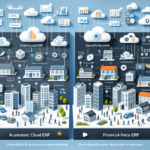FinancialForce ERP vs Odoo ERP: Comprehensive Comparison
Choosing the right Enterprise Resource Planning (ERP) system is crucial for the efficient management and growth of your business. Among the myriad of options available, FinancialForce ERP and Odoo ERP are two prominent contenders. This article provides an in-depth analysis of both platforms, helping you determine which ERP solution aligns best with your business requirements.
Introduction to FinancialForce ERP and Odoo ERP
FinancialForce ERP is a cloud-based solution tailored for businesses of all sizes, offering comprehensive features such as accounting, project management, billing, and inventory management. In contrast, Odoo ERP is an open-source software renowned for its versatility, providing modules like CRM, website builder, e-commerce, and accounting. Both platforms offer unique functionalities that cater to different business needs.
One significant advantage of FinancialForce ERP is its seamless integration with Salesforce, enabling businesses to manage their entire customer lifecycle from a single platform. Additionally, it provides advanced financial reporting capabilities, allowing for deeper insights into financial performance and data-driven decision-making.
On the other hand, Odoo ERP is celebrated for its user-friendly interface and extensive customization options. Its modular approach allows businesses to select and integrate only the modules they need, providing flexibility as business requirements evolve. Furthermore, Odoo ERP supports a wide range of third-party integrations, facilitating connections with other essential business applications.
History and Background
FinancialForce ERP was established in 2009 as a joint venture between Unit4 and Salesforce. It offers a unified cloud platform for professional services automation (PSA), accounting, and human capital management (HCM). Conversely, Odoo ERP (originally known as OpenERP) was founded in 2005, focusing on providing an affordable and easy-to-use solution tailored to the diverse needs of businesses.
Since its inception, FinancialForce ERP has expanded rapidly, serving some of the world's largest companies. The platform is designed to streamline operations and enhance the bottom line, offering various add-ons and integrations to optimize workflows further.
Odoo ERP emphasizes open-source software and community-driven development. Its highly customizable platform includes a vast array of modules and apps that can be added to meet specific business requirements. Additionally, Odoo offers comprehensive training and support services to help businesses maximize the platform’s potential.
Key Features
FinancialForce ERP Features
- Financial Management: Comprehensive tools for managing finances, including accounts payable/receivable, general ledger, and budgeting.
- Revenue Recognition: Automates complex revenue recognition processes, ensuring compliance with accounting standards.
- Customer Relationship Management (CRM): Integrated CRM tools for managing customer interactions and sales pipelines.
- Supply Chain Management: Efficiently manages inventory, procurement, and distribution processes.
- Project Management: Tracks project progress, allocates resources, and manages budgets in real-time.
- Human Capital Management (HCM): Manages employee data, tracks time and attendance, and automates HR processes.
Odoo ERP Features
- Billing and Invoicing: Streamlines billing processes with integrated invoicing capabilities.
- Sales Management: Tools for managing sales pipelines, quotations, and order processing.
- Inventory Management: Comprehensive inventory tracking and management system.
- Point of Sale (POS): Integrated POS system for retail operations.
- E-Commerce Module: Complete online store solution, including website design, payment processing, and shipping integration.
- CRM: Robust CRM tools for managing customer relationships and sales activities.
- User-Friendly Interface: Customizable dashboards tailored to specific business needs.
- Third-Party Integrations: Connects with over 30,000 different modules and applications.
Pros and Cons
FinancialForce ERP
Pros:
- Seamless integration with Salesforce
- Real-time financial information
- High customization flexibility
- Handles complex financial processes like revenue recognition and billing
- Robust reporting and analytics capabilities
Cons:
- Steep learning curve
- Higher pricing compared to some competitors
Odoo ERP
Pros:
- Large user community
- Easy-to-use interface
- Affordability
- Wide range of modules for versatility
- Extensive third-party integrations
Cons:
- Lack of some advanced features found in other ERPs
- Limited official support options
Pricing Comparison
FinancialForce ERP pricing is based on the number of users and selected modules, starting at approximately $110 per user per month. In contrast, Odoo ERP offers a more flexible pricing structure, starting at around $20 per user per month plus the cost of additional modules. Overall, Odoo ERP is generally more affordable compared to FinancialForce ERP.
However, FinancialForce ERP provides more advanced features and customization options, which may justify the higher cost for certain businesses. Its strong focus on financial management makes it an excellent choice for businesses prioritizing financial reporting and analysis.
Odoo ERP, with its user-friendly interface and extensive range of modules—including CRM, inventory management, and project management—serves as a versatile option for businesses needing a comprehensive ERP system that handles multiple functions.
Customer Support and User Interface
Customer Support
FinancialForce ERP offers comprehensive customer support, including:
- 24/7 support with a helpdesk ticketing system
- Live chat support
- Access to a knowledge base
- Dedicated customer success managers for personalized assistance
In contrast, Odoo ERP provides:
- Email support
- Live chat support
- Access to community forums
Overall, FinancialForce ERP offers more robust support options compared to Odoo ERP, including personalized assistance through dedicated customer success managers.
User Interface
FinancialForce ERP features a modern user interface with customizable dashboards and excellent navigation, designed to integrate seamlessly with Salesforce. Key advantages include:
- Real-time data insights through interactive dashboards
- Mobile compatibility for access on the go
Odoo ERP boasts an intuitive and user-friendly interface that is highly customizable, allowing for a seamless user experience. Advantages include:
- Simplicity and ease of use, enabling quick navigation and task performance
- Customizable dashboards tailored to specific business needs
- Mobile compatibility, though not as optimized as FinancialForce ERP
Integration and Security Features
Integration Capabilities
Both FinancialForce ERP and Odoo ERP offer robust integration capabilities with third-party applications and software:
- FinancialForce ERP: Tight integration with Salesforce enhances its functionality for businesses already using Salesforce products.
- Odoo ERP: Supports integration with over 30,000 different modules, providing extensive flexibility for various business needs.
Security Features
Security is a top priority for both platforms, offering high-level security features such as:
- Data encryption
- Two-factor authentication
- Permissions for user access control
FinancialForce ERP provides additional security features including:
- Audit trails
- Compliance and regulatory adherence
These enhancements ensure data security and privacy, making FinancialForce ERP a robust choice for businesses with stringent security requirements.
Key Industries and Case Studies
Key Industries
FinancialForce ERP is utilized across various industries, including:
- Professional services
- Non-profit organizations
- Healthcare
- Manufacturing
Odoo ERP caters to industries such as:
- Manufacturing
- Retail
- Education
- E-commerce
Both platforms serve a wide range of industries, making them suitable options for most businesses.
Case Studies
Several companies have successfully implemented FinancialForce ERP or Odoo ERP. For instance:
- Siemens utilizes FinancialForce ERP to enhance their project management processes.
- Marc Jacobs employs Odoo ERP to manage their financial operations and inventory management systems.
Future Developments
Both FinancialForce ERP and Odoo ERP are continuously evolving to meet the dynamic needs of businesses:
- FinancialForce ERP: Leveraging artificial intelligence and machine learning to enhance its features and provide more predictive analytics.
- Odoo ERP: Developing more industry-specific modules to cater to specialized business requirements and improving overall system performance.
These advancements ensure that both platforms remain at the forefront of ERP innovations, providing businesses with cutting-edge tools to stay competitive.
Conclusion: Choosing the Right ERP for Your Business
Ultimately, the choice between FinancialForce ERP and Odoo ERP hinges on your business's specific requirements:
- FinancialForce ERP: Best suited for businesses seeking advanced features, robust financial management, and those willing to invest more resources.
- Odoo ERP: Ideal for businesses looking for an affordable, flexible, and user-friendly solution with a wide range of modules.
When deciding, consider factors such as your budget, business size, and specific operational needs to select the ERP system that will best support your organization's growth and efficiency.




















